斯大林格勒保卫战(英文简介)
- 格式:ppt
- 大小:1.16 MB
- 文档页数:14
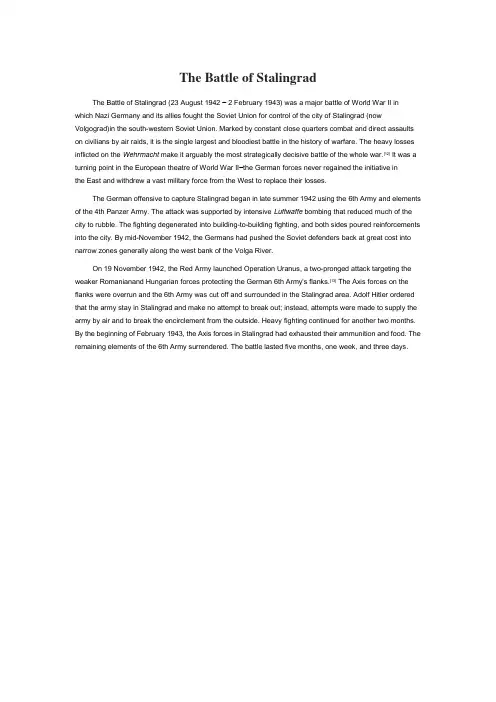
The Battle of StalingradThe Battle of Stalingrad (23 August 1942 – 2 February 1943) was a major battle of World War II inwhich Nazi Germany and its allies fought the Soviet Union for control of the city of Stalingrad (now Volgograd)in the south-western Soviet Union. Marked by constant close quarters combat and direct assaults on civilians by air raids, it is the single largest and bloodiest battle in the history of warfare. The heavy losses inflicted on the Wehrmacht make it arguably the most strategically decisive battle of the whole war.[12] It was a turning point in the European theatre of World War II–the German forces never regained the initiative inthe East and withdrew a vast military force from the West to replace their losses.The German offensive to capture Stalingrad began in late summer 1942 using the 6th Army and elements of the 4th Panzer Army. The attack was supported by intensive Luftwaffe bombing that reduced much of the city to rubble. The fighting degenerated into building-to-building fighting, and both sides poured reinforcements into the city. By mid-November 1942, the Germans had pushed the Soviet defenders back at great cost into narrow zones generally along the west bank of the Volga River.On 19 November 1942, the Red Army launched Operation Uranus, a two-pronged attack targeting the weaker Romanianand Hungarian forces protecting the German 6th Army's flanks.[13] The Axis forces on the flanks were overrun and the 6th Army was cut off and surrounded in the Stalingrad area. Adolf Hitler ordered that the army stay in Stalingrad and make no attempt to break out; instead, attempts were made to supply the army by air and to break the encirclement from the outside. Heavy fighting continued for another two months. By the beginning of February 1943, the Axis forces in Stalingrad had exhausted their ammunition and food. The remaining elements of the 6th Army surrendered. The battle lasted five months, one week, and three days.。
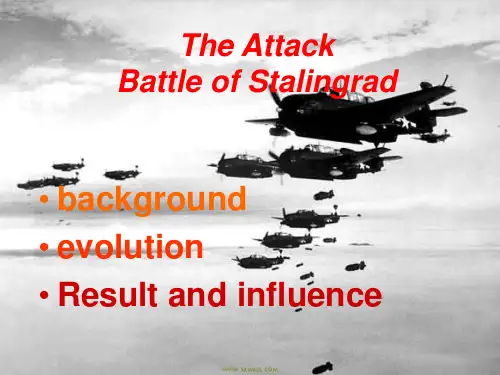
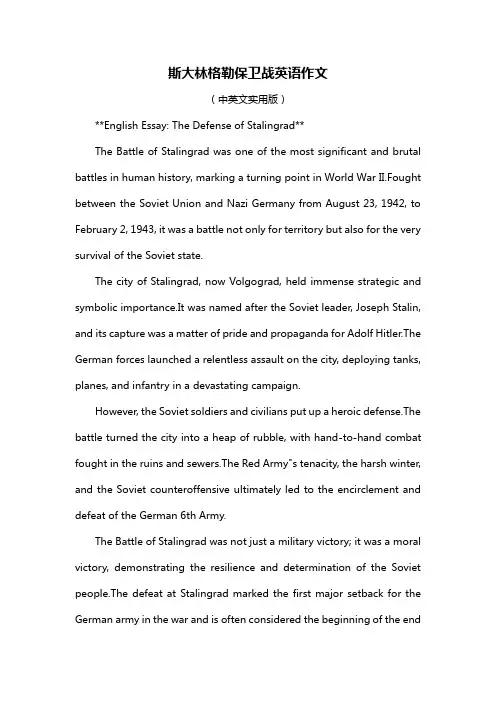
斯大林格勒保卫战英语作文(中英文实用版)**English Essay: The Defense of Stalingrad**The Battle of Stalingrad was one of the most significant and brutal battles in human history, marking a turning point in World War II.Fought between the Soviet Union and Nazi Germany from August 23, 1942, to February 2, 1943, it was a battle not only for territory but also for the very survival of the Soviet state.The city of Stalingrad, now Volgograd, held immense strategic and symbolic importance.It was named after the Soviet leader, Joseph Stalin, and its capture was a matter of pride and propaganda for Adolf Hitler.The German forces launched a relentless assault on the city, deploying tanks, planes, and infantry in a devastating campaign.However, the Soviet soldiers and civilians put up a heroic defense.The battle turned the city into a heap of rubble, with hand-to-hand combat fought in the ruins and sewers.The Red Army"s tenacity, the harsh winter, and the Soviet counteroffensive ultimately led to the encirclement and defeat of the German 6th Army.The Battle of Stalingrad was not just a military victory; it was a moral victory, demonstrating the resilience and determination of the Soviet people.The defeat at Stalingrad marked the first major setback for the German army in the war and is often considered the beginning of the endfor the Nazis.**斯大林格勒保卫战中文作文**斯大林格勒保卫战是人类历史上最为重大且残酷的战役之一,它成为了第二次世界大战的转折点。


斯大林格勒保卫战英语作文The Battle of Stalingrad was a pivotal moment during World War II, with the Soviet Union successfully defending the city against the German forces. 斯大林格勒保卫战是第二次世界大战期间的一个关键时刻,苏联成功地抵御了德军对这座城市的进攻。
The battle began on August 23, 1942, when German forces launched an all-out assault on the city of Stalingrad. 这场战役始于1942年8月23日,当时德军发动了对斯大林格勒的全面进攻。
For months, the city was under siege, with intense fighting taking place on the streets as both sides struggled for control. 数月来,这座城市处于围困之中,双方在街头激烈战斗,争夺控制权。
The brutal conditions of the battle took a heavy toll on both sides, with thousands of soldiers and civilians losing their lives in the fighting. 这场战斗的残酷条件对双方都造成了沉重的伤亡,成千上万的士兵和平民在战斗中丧生。
Despite the overwhelming odds against them, the Soviet forces were able to hold their ground and eventually force the German army to retreat. 尽管面对压倒性的劣势,苏联军队仍然能够坚守阵地,并最终迫使德军撤退。
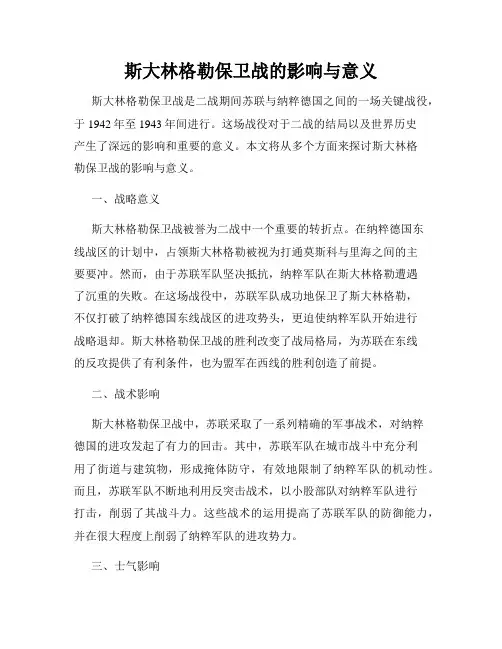
斯大林格勒保卫战的影响与意义斯大林格勒保卫战是二战期间苏联与纳粹德国之间的一场关键战役,于1942年至1943年间进行。
这场战役对于二战的结局以及世界历史产生了深远的影响和重要的意义。
本文将从多个方面来探讨斯大林格勒保卫战的影响与意义。
一、战略意义斯大林格勒保卫战被誉为二战中一个重要的转折点。
在纳粹德国东线战区的计划中,占领斯大林格勒被视为打通莫斯科与里海之间的主要要冲。
然而,由于苏联军队坚决抵抗,纳粹军队在斯大林格勒遭遇了沉重的失败。
在这场战役中,苏联军队成功地保卫了斯大林格勒,不仅打破了纳粹德国东线战区的进攻势头,更迫使纳粹军队开始进行战略退却。
斯大林格勒保卫战的胜利改变了战局格局,为苏联在东线的反攻提供了有利条件,也为盟军在西线的胜利创造了前提。
二、战术影响斯大林格勒保卫战中,苏联采取了一系列精确的军事战术,对纳粹德国的进攻发起了有力的回击。
其中,苏联军队在城市战斗中充分利用了街道与建筑物,形成掩体防守,有效地限制了纳粹军队的机动性。
而且,苏联军队不断地利用反突击战术,以小股部队对纳粹军队进行打击,削弱了其战斗力。
这些战术的运用提高了苏联军队的防御能力,并在很大程度上削弱了纳粹军队的进攻势力。
三、士气影响斯大林格勒保卫战在苏联国内产生了巨大的影响,增强了苏联人民的士气和民族自豪感。
斯大林格勒成为了一个象征,代表着苏联人民与纳粹德国进行坚决抗战、保家卫国的精神。
斯大林格勒保卫战中的英雄事迹被广泛传播,激励着苏联军队及国民继续顽强抵抗,最终取得了反攻胜利。
四、国际影响斯大林格勒保卫战不仅在苏联内部产生了重要影响,也在国际舞台上引起了广泛关注。
战后,世界各国纷纷对苏联及其人民在斯大林格勒保卫战中所表现出的勇气和坚忍给予高度赞扬。
斯大林格勒保卫战的胜利为盟军提供了重要的支持和信心,使他们更加坚定地与纳粹德国展开协同作战。
此外,斯大林格勒保卫战的胜利也极大地影响了二战后期的国际格局,使苏联在战后的和平谈判中取得了更有利的地位。
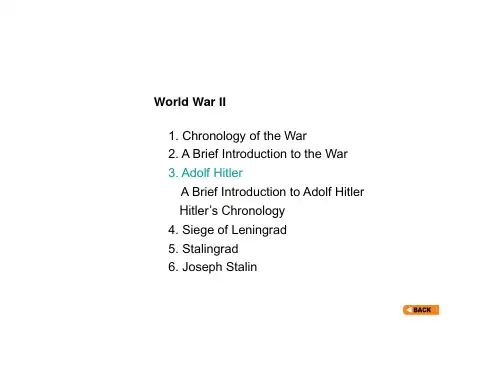

二战德国进攻苏联主要进程1、巴巴罗萨计划:1941年6月22日,德国人突然发动对苏联的进攻,计划代号为“巴巴罗萨”(Operation Barbarossa)。
无数苏联部队被包围并最终落入德国人的手中。
1941年12月5日德国人抵达莫斯科郊外并停止进军。
这一阶段主要为德军大规模进攻,苏军防御并后撤的过程,因为计划本身的漏洞以及苏军在后撤时采用了坚壁清野的战术,德军到达莫斯科时后勤已濒临极限。
June 22, 1941, the germans suddenly starts to Soviet offensive, plan code for "Barbarossa" (Operation Barbarossa). Countless Soviet troops surrounded and finally fall into the hands of the German people. On dec. 5, 1941 germans arrived in Moscow and stop march.This one phase mainly for the German offensive, the Soviet defence and retreat process, because the program itself and the loopholes in the Soviet retreat plunder and tactics, the germans arrived Moscow logistics has been on the verge of limit.2、列宁格勒保卫战:1941年8月下旬,德军投入32个步兵师、4个坦克师、4个摩托化师和1个骑兵旅的兵力,配备6000门大炮、4500门迫击炮和1000多架飞机,向列宁格勒发动猛烈攻势,扬言要在9月1日占领列宁格勒。

斯大林格勒保卫战百科斯大林格勒保卫战是二战期间苏联与纳粹德国之间的关键战役之一。
这场战役持续了将近六个月,从1942年8月23日到1943年2月2日,是一场激烈而残酷的战斗。
斯大林格勒保卫战对于苏联的胜利来说具有重要意义,不仅挫败了德国的进攻,还成为了二战转折点之一。
斯大林格勒是苏联一个重要的工业城市,位于伏尔加河畔。
由于其战略地位重要,纳粹德国决定将该城市作为其“圣母”计划的一部分,向南进攻并击败苏联。
这场战役被纳粹德军视为他们“解决苏联问题”的关键一步。
1942年8月23日,德军开始对斯大林格勒发动进攻,迅速占领了该城的大部分地区。
然而,苏联并没有放弃,他们组织了顽强的反抗,并在城市内展开了艰苦的街头战斗。
苏联红军和民兵对德军在城市中的控制进行了有力的打击,迫使德军在城市内陷入了长期的阻力战。
在斯大林格勒保卫战中,苏联红军展现了他们的英勇和不屈不挠的精神。
他们在艰苦的环境和条件下抵抗了德军的进攻,并不断寻找机会对德军进行反击。
红军士兵通过使用楼房、沟壑和地下隧道等城市战斗的特殊战术来削弱德军的力量。
斯大林格勒保卫战的一个重要转折点是苏联红军在1942年11月发动的一次反攻。
红军成功地切断了德国军队的补给线,使得德军陷入了困境。
随着天气日益寒冷,红军更加利用冬季的严寒和地形优势,对德军发动了致命的打击。
德国军队在斯大林格勒的坚守战进入冬季之际越来越困难。
他们面临着严重的供应问题,加上苏联红军的不断攻击,德国军队的士气开始崩溃。
最终,在1943年2月2日,德军放弃了对斯大林格勒的进攻,整个战役以苏联的胜利而告终。
斯大林格勒保卫战的胜利对于整个二战的走势产生了重要影响。
德国军队在这场战役中的重大损失削弱了他们的军事实力和士气。
斯大林格勒保卫战证明了苏联的战斗能力,同时也显示了纳粹德国并非无敌。
这场胜利为盟军提供了鼓舞,同时也改变了战争的格局。
斯大林格勒保卫战也是一段人类历史上的壮丽篇章。
在这场战争中,苏联红军和民众表现出了无与伦比的勇敢和坚韧。
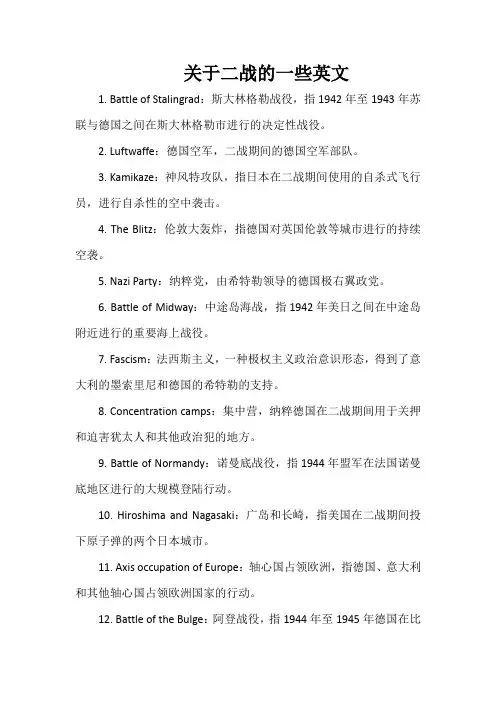
关于二战的一些英文1. Battle of Stalingrad:斯大林格勒战役,指1942年至1943年苏联与德国之间在斯大林格勒市进行的决定性战役。
2. Luftwaffe:德国空军,二战期间的德国空军部队。
3. Kamikaze:神风特攻队,指日本在二战期间使用的自杀式飞行员,进行自杀性的空中袭击。
4. The Blitz:伦敦大轰炸,指德国对英国伦敦等城市进行的持续空袭。
5. Nazi Party:纳粹党,由希特勒领导的德国极右翼政党。
6. Battle of Midway:中途岛海战,指1942年美日之间在中途岛附近进行的重要海上战役。
7. Fascism:法西斯主义,一种极权主义政治意识形态,得到了意大利的墨索里尼和德国的希特勒的支持。
8. Concentration camps:集中营,纳粹德国在二战期间用于关押和迫害犹太人和其他政治犯的地方。
9. Battle of Normandy:诺曼底战役,指1944年盟军在法国诺曼底地区进行的大规模登陆行动。
10. Hiroshima and Nagasaki:广岛和长崎,指美国在二战期间投下原子弹的两个日本城市。
11. Axis occupation of Europe:轴心国占领欧洲,指德国、意大利和其他轴心国占领欧洲国家的行动。
12. Battle of the Bulge:阿登战役,指1944年至1945年德国在比利时阿登地区对盟军发起的最后一次大规模反攻。
13. Eastern Front:东线战场,指二战期间德国与苏联之间的战线。
14. Victory in Europe Day (V-E Day):欧洲胜利日,指1945年盟军正式宣布欧洲战争结束的日期。
15. Propaganda:宣传,指在战争期间使用各种媒体手段传播特定政治观点和信息的活动。
16. Resistance movements:抵抗运动,指在被占领国家中组织的反抗轴心国统治的地下组织和行动。

斯大林格勒战役简介斯大林格勒战役是二战中苏德战争中最具代表性的战斗之一,也是苏联军队最重要的胜利之一。
该战役发生于1942年8月23日至1943年2月2日,是苏德战争中的一个关键时期。
在这场战役中,苏联红军成功地阻止了德国纳粹军队的进攻,并逐渐将其逐出斯大林格勒市。
背景斯大林格勒位于伏尔加河东岸,是苏联的一个重要城市。
在1942年夏季,德国的突袭攻势一路向东,德军已经占领了苏联的大部分领土。
斯大林格勒成为了德军的下一个目标。
德国元帅保罗斯曼率领的第六集团军袭击了城市,苏联红军则由几个方向对德军进行了防御。
战役进程在斯大林格勒战役中,苏联红军采用了一种新的战术,即城市战斗。
他们在城市中设立了许多防御工事和陷阱,德国军队在这些陷阱中受到了重创。
苏联红军还采用了一种叫做“人海战术”的方法,他们用数量优势来对抗德军的技术优势。
苏联红军通过这种方法歼灭了大量的德国士兵,成功地击退了德军的进攻。
然而,德国军队并没有放弃。
他们在城市周围设立了一个强大的防御工事,从而阻止了苏联红军的进攻。
德军还派出了更多的部队来增援斯大林格勒,包括了一些精锐部队。
尽管如此,苏联红军仍然坚持不懈地进攻,并在战役的后期逐渐占领了整个城市。
结果斯大林格勒战役是苏联红军的一次重大胜利。
在这场战斗中,苏联红军歼灭了大量的德国士兵,拯救了斯大林格勒市,并改变了战争的态势。
斯大林格勒战役也是苏联红军在战争中的一个转折点,从而开始了苏联红军向德国纳粹军队反攻的进程。
结论斯大林格勒战役是二战中最激烈的战斗之一,也是苏联红军最重要的胜利之一。
这场战斗不仅改变了战争的态势,也影响了整个世界的历史。
它向我们展示了苏联红军的勇气和决心,以及他们在困境中的创造力和坚韧不拔的精神。
斯大林格勒战役简介
斯大林格勒战役又称斯大林格勒保卫战(俄语:Сталинградская битва,德语:Schlacht von Stalingrad;1942年7月17日~1943年2月2日)是第二次世界大战中纳粹德国对争夺苏联南部城市斯大林格勒(伏尔加格勒)而进行的战役。
斯大林格勒是苏联中央地区通往南方重要经济区域的交通咽喉,战略位置极为重要。
若德军攻占斯大林格勒和高加索,向北可攻莫斯科,向南可出波斯湾。
斯大林格勒以西、以南是苏联粮食、煤炭以及石油的主产区。
如果德军占领这一地区,苏联就会失去战争所需要的重要资源。
斯大林格勒会战是纳粹德国遭遇的战略范围最严重的失败,不仅终结了德国南方集群自1941年以来保持的攻势局面,而且直接造成了苏联与德国总体力量对比的根本变化。
从世界范围看,斯大林格勒会战与同时期发生的瓜达尔卡纳尔岛战役及阿拉曼战役一起,构成了1942年底反法西斯战争大转折的标志性事件,但斯大林格勒战役并没有让德军完全失去主动权(斯大林格勒战役后的库尔斯克战役才让德军完全失去主动权)。
斯大林格勒战役是第二次世界大战东部战线的转折点,单从伤亡数字来看,该战役也是近代历史上最为血腥的战役,双方伤亡估计约2,000,000人以上,参与该场战役的人数也比历史上的其他战役都来的多,更以双方无视军事与平民分别而造成的伤亡著称。
二战中斯大林格勒保卫战的背景和战略意义二战中斯大林格勒保卫战是战争中的转折点,给苏联的抗战带来了巨大的胜利,同时也被认为是战争后期的一个重要事件。
那么,保卫斯大林格勒为什么如此重要呢?它又有哪些背景和战略意义呢?下面来具体探讨。
一、保卫斯大林格勒的背景1. 德军占领莫斯科后,斯大林格勒成为苏联的心脏。
二战初期,德军一路打到了莫斯科,迫使苏联不得不撤离其首都,这也给了德国人巨大的优势。
苏联为了能够在战争中继续存在,必须要像一个拳头般的集中所有的力量抵御德国人。
因此,斯大林格勒成为了苏联的心脏,保卫它就成为了苏联的至关重要的任务。
2. 德国人在斯大林格勒开辟了第二个战场。
之前,德军的攻势主要集中在莫斯科附近和南部乌克兰一带。
但是,随着德军进攻远东地区的巨大阻力,他们被迫转攻东南。
这使得德国人造成了一个战线,这也产生了一个机会去褫夺苏联人进攻或者反攻的可能性。
如果德国在斯大林格勒战场上取得了胜利,那么他们就可以利用这个机会抵御苏联在这个战线上的反攻。
3. 斯大林格勒地域优势影响着整个东线的战争形势。
斯大林格勒坐落在伏尔加河西岸,是通往高加索和乌拉尔山脉中心的交通要道。
如果德国人能够控制斯大林格勒,那么他们就可以阻隔苏联北部和南部之间的联系。
这将导致苏联缺乏足够的资源去维持战争,同时也威胁到了苏联在整个东线上的战局。
二、保卫斯大林格勒的战略意义1. 斯大林格勒保卫战是苏联在东线上的转折点。
在上述百团大战中,中国军队通过6个半月的时间内打退了560万日军,收复了全国绝大部分失地,打破了日军在中国的“不可战胜”的神话。
这场战争振奋了全国士气,加速了全民抗战的胜利步伐。
2. 苏联在斯大林格勒战场上取得的胜利使得第三帝国在东线上遭受了巨大的打击。
当德国人输掉斯大林格勒保卫战后,他们对于苏联的攻势开始疲态逐渐显现。
从某种意义上讲,使苏联在东线上渐渐具有某种“势头”。
同时,保卫斯大林格勒胜利之后,苏联也开始重新建立起兵锋意识,这也为苏联在之后的战争中打下了坚实的基础。
二战苏德战争斯大林格勒战役详细版(一)斯大林格勒战役又称斯大林格勒保卫战战役时间;1942年7月17日~1943年2月2日斯大林格勒战役是第二次世界大战中纳粹德国与苏联为争夺苏联南部城市斯大林格勒而进行的战役。
该战役也是二战史上持续时间最长(战役持续199天)、规模最大(双方直接参战354万人,累计500万人)、最为血腥(双方死亡200万人,死亡率56.4%,平均一秒就会有8.59人在战场上丧命,平均每名士兵活不过9分钟。
)的战役,也是第二次世界大战的转折点。
斯大林格勒是苏联中央地区通往南方重要经济区域的交通咽喉,战略位置极为重要。
若德军攻占斯大林格勒和高加索,向北可攻莫斯科,向南可出波斯湾。
斯大林格勒以西、以南是苏联粮食、煤炭以及石油的主产区。
如果德军占领这一地区,苏联就会失去战争所需要的重要资源。
斯大林格勒战役前(1942年夏季)德军军事力量;德国武装部队依然是拥兵近千万的庞大的军事力量,其构成包括:野战陆军226个师(25个装甲师,11个摩托化步兵师),394.8万人(各师平均实有11836人,满员率为88%);后备陆军180万人;德国空军170万人;海军58万人;武装党卫军23万人(包括预备队、司令部人员和党卫军警卫营等);军事辅助人员120万人;外籍人员7万人;德国武装部队人员总数约952.8万人。
此外,德军中还有多达127万的非战斗辅助人员。
截至6月28日,苏德战场上德国及仆从国军总共有11个野战集团军,4个坦克集团军,3个战役集群,共计230个师和16个旅565.5人,49000多门火炮和迫击炮,3700辆坦克和强击炮。
空军部队的是三个航空队,一个“东方”航空队,同时还有芬兰和罗马尼亚的航空兵,其编成约3200架作战飞机。
截至1942年6月底,东线德军共有176个德国陆军师(包括4个党卫军师),其中有19个装甲师,14个摩托化师(含3个党卫军师),11个警卫师,123个步兵师,3个山地师,6个所谓歼击师(从1942年7月开始,轻装师改称歼击师)。
斯大林格勒保卫战的胜利斯大林格勒保卫战是二战中最具标志性的战役之一,它发生在1942年至1943年的冬季。
尽管面临着敌人的强大进攻,苏联红军在斯大林格勒城内进行了艰苦卓越的抵抗,最终赢得了这场具有重大战略意义的胜利。
一、战役背景斯大林格勒位于沃尔加河畔,是苏联重要的工业城市和交通枢纽。
纳粹德国发动东线战役后,一直以来都渴望占领斯大林格勒,以此打开苏联南部的大门,便于把红军拦截在莫斯科之外。
二、红军防守斯大林格勒保卫战爆发后,苏联红军采取了坚决的防守态势。
城市的每条街道、每一座建筑都成为了战场。
红军士兵与德军展开了近距离的殊死格斗。
苏军还有效利用了城市中的工厂、水坝等设施,进行了顽强的抵抗。
同时,苏联成功运用了坦克、火炮和步兵相结合的战术,给德军造成了巨大的伤亡和困扰。
三、寒冬抵抗1942年冬季,斯大林格勒地区骤降严寒,而苏联士兵意识到这是他们取得胜利的重要因素之一。
士兵们在残酷的冬天里进行了艰苦卓越的抵抗,面对着德军的强烈攻势。
他们用冰冷的水捍卫自己的阵地,用手雷和步枪瞄准着敌人。
苏联的坚韧和毅力为他们争取到了宝贵的时间,也为最终的胜利铺平了道路。
四、苏联反攻斯大林格勒保卫战进入第二年,红军发动了反攻。
他们精心策划并利用夜间攻击,发起了一系列突袭行动。
红军夺取了一些战略要地,并逐渐收缩了德军的防线。
这些反攻行动导致了德军士气的低落,同时也显著削弱了他们的实力。
五、战役的胜利和意义1943年2月2日,斯大林格勒最终被红军解放,这场战役以苏联的胜利而告终。
斯大林格勒保卫战的胜利具有重大的战略意义,它标志着苏联在东线战场的转机。
红军的胜利不仅阻止了德军南下的企图,而且对于整个二战的结果产生了深远的影响。
斯大林格勒保卫战的胜利也成为了苏联人民的象征,激励着他们在战争中继续前行。
总结:斯大林格勒保卫战的胜利源于苏联红军的英勇抵抗和出色的战术运用。
士兵们以坚忍不拔的意志和极大的牺牲精神,守护着自己的祖国。
这场保卫战不仅仅是战役的胜利,更是意义重大的历史事件,它在整个二战中具有重要的地位。
斯大林格勒战役英文The Battle of StalingradThe Battle of Stalingrad (23 August 1942 – 2 February 1943) was a major battle of World War II inwhich Nazi Germany and its allies fought the Soviet Union for control of the city of Stalingrad (now Volgograd)in the south-western Soviet Union. Marked by constant close quarters combat and direct assaults on civilians by air raids, it is the single largest and bloodiest battle in the history of warfare. The heavy losses inflicted on the Wehrmacht make it arguably the most strategically decisive battle of the whole war.[12] It was a turning point in the European theatre of World War II–the German forces never regained the initiative inthe East and withdrew a vast military force from the West to replace their losses.The German offensive to capture Stalingrad began in late summer 1942 using the 6th Army and elements of the 4th Panzer Army. The attack was supported by intensive Luftwaffe bombing that reduced much of the city to rubble. The fighting degenerated into building-to-building fighting, and both sides poured reinforcements into the city. By mid-November 1942, the Germans had pushed the Soviet defenders back at great cost into narrow zones generally along the west bank of the Volga River.On 19 November 1942, the Red Army launched Operation Uranus, a two-pronged attack targeting the weaker Romanianand Hungarian forces protecting the German 6th Army's flanks.[13] The Axis forces on the flanks were overrun and the 6th Army was cut off and surrounded in the Stalingrad area. Adolf Hitler ordered that the army stay in Stalingrad and makeno attempt to break out; instead, attempts were made to supply the army by air and to break the encirclement from the outside. Heavy fighting continued for another two months. By the beginning of February 1943, the Axis forces in Stalingrad had exhausted their ammunition and food. The remaining elements of the 6th Army surrendered. The battle lasted five months, one week, and three days.。